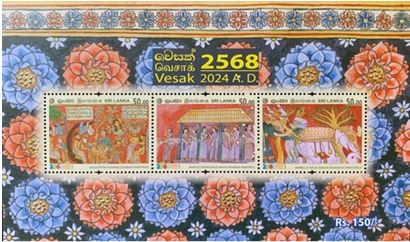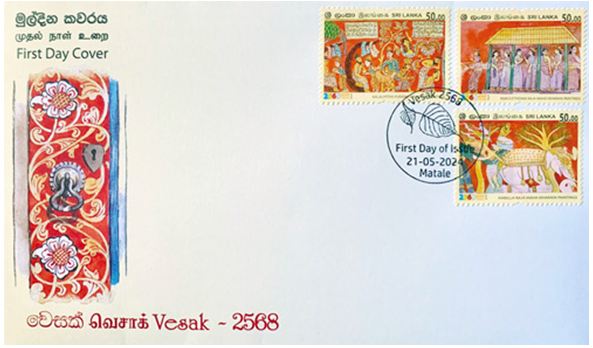

Home/Active Page

Sri Lanka Philatelic Bureau of the Department of Posts will issue three new postage stamps in the denomination of Rs.50.00 each and a souvenir sheet on 21ST May 2024, in order to celebrate the B.E. 2568 Vesak festival.
These stamps depict the murals of Kandy era from Kalalpitiya Purana Viharaya, MakulethennaRajamahaViharaya and AmbillaRajamahaViharaya, which are three historical Buddhist temples located in the Matale district.
| Date of Issue | 21st March 2024 |
| Denomination | Rs.50.00 X 3 |
| Catalogue No: | CSL 2571- Kalalpitiya Purana Viharaya |
| Stamp Art By | Palith Gunasinghe |
| Stamp Size: | 41mmx 30 mm |
| Sheet Composition: | 20 stamps per sheet |

The Matale district is a geographic region that has been the site of historical events spanning different periods of time. Many important archaeological and religious monuments are situated in this district.
The settlement of the area dates back to prehistoric times. Excavations carried out in Aligala Cave and Pothana near Sigiriya have unearthed prehistoric human skeletons, the stone tools they used, as well as bone fragments from the animals they consumed. Subsequently, burial grounds representing the Megalithic culture from the prehistoric period have been discovered in areas such as Ibbankatuwa and Yatigalpothttha.
Numerous ancient Buddhist monasteries dating back to the early Anuradhapura period, along with many Brahmi inscriptions, have also been identified in the Matale district.
Sacred sites such as Kaludiyapokuna, Enderagala, and Manikdena, which are associated with RangiriDambulu Vihara, Alu Vihara, and Sigiriya, hold significance. Sigiriya, which served as the capital during the reign of King Kashyapa I in the Middle Anuradhapura era, stands as the primary archaeological site in the district.
Matale, a prominent destination during the Kandy era, has numerous Buddhist shrines such as Len Vihara and Tampita Vihara. Temples like Dambulla, Salagama, Alu Viharaya, Hulangamuwa, and Dambawa feature frescoes from the Kandy era.
The temple is located 500m along the Halangoda road, to the left of the Kalalpitiya junction, which is approximately 20km from Kandy to Matale. Although there is no definitive evidence about the temple's origin, legend suggests that it was built during the Walagamba era. It is said that the name 'Kalalpitiya' originated from the assistance provided by the village chief to the Buddhist Council held in Alu Viharaya and as a reward, he was gifted a carpet used by the Rahat Theros, which he buried and used to construct a pagoda at this location. Paintings belonging to the Kandy era can be seen here and they seem to be close to the lowland tradition. These include depictions of Arahants, canopy paintings, and scenes from the Sama and Dhamasoda Jataka stories.
From Weragama Junction on Ratthota Road in Matale, heading towards Bandarapola, this temple is located next to the road after about 2 km. The temple was founded by King GodapolaVijayapala. Here, the Dharmashala, Tampita Vihara, and the library have been built in connection with each other, and the Tampita Vihara has been renovated later. During recent conservation efforts, paintings from the Kandy era, which were drawn on the boards of the canopy of the upper outer floor, have been unearthed.
EmbillaRajamahaViharaya, located approximately 1 km along the Hulangamuwa road from Matale town, is divided into two parts: the Upper Vihara and the Lower Vihara. It is said that the Bodhi tree in the lower temple is one of the two Bodhi trees of Jaya Sri Maha Bodhi, believed to have been planted during the reign of Devanapatis. The upper temple houses early Brahmi script, as well as paintings and statues from the Kandy era.
T. M. C. Bandara
Research Officer
Department of Archaeology
All rights received. All right to identify the Department of Posts as the Author and designer of this Bulleting has been asserted in accordance with the Copyright, Design and Patents Act 1988.No part to this publication may be reproduced, stored in or introduced into a retrieval system, or transmitted in any form or by and means (electronic, mechanical, photocopying, recording or otherwise) without the prior permission from the publisher. Any person who does and unauthorized act in relation to this publication may be liable to criminal